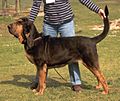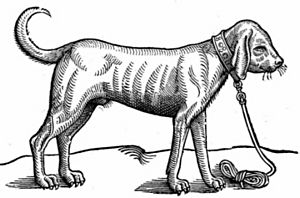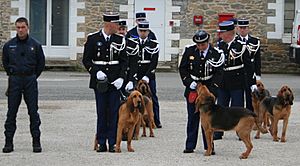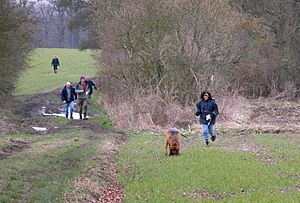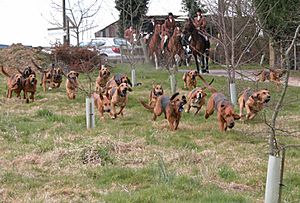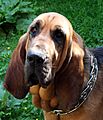Bloodhound facts for kids
The bloodhound is a large dog breed famous for its amazing ability to track scents. These dogs stand about 23–27 inches (58–69 cm) tall and weigh 80–110 pounds (36–50 kg). They have a long nose, big floppy ears, and wrinkled skin on their faces. Their fur is short, and their coats are usually brown and black. Bloodhounds are known for being gentle and loving pets. On average, a Bloodhound lives for about six years and nine months. Because they are so good at tracking, police often use Bloodhounds to find people.
Contents
What They Look Like
Bloodhounds can weigh from 80 to 160 pounds (36 to 72 kg). They are 23 to 27 inches (58 to 69 cm) tall at their shoulders. Dog show judges often prefer larger Bloodhounds. The accepted colors for Bloodhounds are black and tan, liver (a reddish-brown) and tan, or solid red.
Bloodhounds have a very strong and heavy bone structure. Most of their weight comes from their thick bones. Their fur is short and tough, typical for a scent hound, which means it's just fur, not a mix of fur and hair.
Their Personality
This breed is gentle and never gets tired when following a scent. Because their tracking instinct is so strong, they can sometimes be stubborn. This can make it a bit hard to train them to obey commands or walk nicely on a leash.
Bloodhounds are loving and calm with people, which makes them great family pets. However, like any pet, they should be watched when they are around small children.
Colors and Patterns
Bloodhounds come in a few main colors: black and tan, liver and tan, and red. Sometimes, they might have white patches on their chest or feet.
The different colors and patterns are caused by special genes. For example, one gene controls whether the dog has black or brown (liver) coloring. If a Bloodhound gets the black gene from either parent, its nose, eye rims, and paw pads will be black. If it gets the recessive brown gene from both parents, these parts will be liver-colored.
Another gene affects the pattern of their coat. This gene can make them:
- Mostly tan (called 'red' in Bloodhounds).
- Have a 'saddle' marking, which is a darker patch on their back.
- Be mostly covered in darker color (black or liver), with tan only on their lips, eyebrows, chest, and lower legs. These are sometimes called 'blanket' or 'full-coat' types.
You can see examples of these different types in the pictures below.
How Long They Live
In a 2004 survey in the UK, Bloodhounds lived for about 6.75 years on average. This makes them one of the dog breeds with a shorter lifespan.
History of Bloodhounds
The St. Hubert Hound
Legend says that the St. Hubert hound was first bred around 1000 AD by monks at the Saint-Hubert Monastery in Belgium. However, it likely came from France, where many modern hound breeds originated. This breed is thought to be the ancestor of several other hound breeds.
Around the 1200s, the monks of St. Hubert Abbey would send pairs of black hounds as gifts to the King of France every year. These dogs were not always highly valued by the French kings. By the early 1700s, they became quite rare. Many experts believe that the original St. Hubert breed died out in the 1800s. The modern European St. Hubert hound exists today because of the development of the Bloodhound.
The Bloodhound Breed
References to Bloodhounds first appeared in English writings in the early to mid-1300s. This suggests the breed was already well-known then. Some people say their ancestors were brought to England by William the Conqueror, but there is no clear proof of this.
In medieval times, Bloodhounds were often used as 'limers' or 'lyam-hounds'. This meant they were kept on a leash to find deer or wild boar before the main hunting pack began the chase. They were valued for their ability to follow an old scent of a single animal. Even though they usually didn't help with the final catch, they received a special reward from the hunted animal.
From very early times, Bloodhounds were also used to track people. There are old stories from medieval Scotland about famous figures like Robert the Bruce and William Wallace being followed by 'sleuth hounds'. These stories show that the 'sleuth hound' was known for tracking people, and it later became clear that the sleuth hound and the Bloodhound were the same dog.
Over time, as fox-hunting became more popular and deer-hunting declined, the use of Bloodhounds decreased. Only a few wealthy owners and enthusiasts kept them. Their popularity began to grow again in the 1800s with the rise of dog shows.
In the late 1800s, French dog lovers imported many Bloodhounds from Britain. They wanted to bring back the ancient St. Hubert breed, believing the Bloodhound was its unchanged form.
It's not known exactly when the first Bloodhounds came to the USA. In the past, Bloodhounds were used to track lost people and criminals. Later in the 1800s, more purebred Bloodhounds were brought from Britain and bred in America. This was especially true after 1888, when an English breeder named Edwin Brough showed three of his hounds in New York City.
In America, Bloodhounds have been used more widely to find lost people and criminals, often with great success. The history of Bloodhounds in America is full of stories about amazing Bloodhounds and their skilled handlers, like the famous hound Nick Carter. Police and other law enforcement agencies have used Bloodhounds a lot. In Britain, Bloodhounds have also been used successfully to track criminals or missing people from time to time.
Today, Bloodhounds are found all over the world, though their numbers are small in most countries. The USA has more Bloodhounds than anywhere else. Thanks to international breeding and even artificial insemination, the world's Bloodhound population remains connected, with not much difference in type between countries.
How Bloodhounds Work
Their Amazing Sense of Smell
A Bloodhound's physical features help it follow a scent trail that is several days old. In perfect conditions, a Bloodhound can detect even one or two cells of scent. Some dog breeds, like Bloodhounds, have nearly 300 million scent receptors in their noses.
Their large, long, floppy ears help stop the wind from blowing away nearby skin cells when the dog's nose is on the ground. The loose, wrinkled skin under their lips and neck, called the 'shawl', helps catch scent particles in the air or on a nearby branch. This helps the dog remember and process the scent. However, not everyone agrees that these features are helpful; some think they might even be a disadvantage.
Tracking People
There are many stories of Bloodhounds successfully following trails that are many hours, or even several days, old. One record tells of a family found in Oregon in 1954, more than 330 hours (over 12 days) after they went missing.
Bloodhounds are usually used to follow the unique scent of a person who is lost or has run away. They start by sniffing a 'scent article' – something the person is known to have touched, like a piece of clothing or a car seat. Many Bloodhounds will follow the scent from a distance, not just the exact footsteps. This allows them to take shortcuts and reach the end of the trail faster. In America, following exact footsteps is called 'tracking', while the freer method is called 'trailing'. This shows how Bloodhounds focus on the individual human scent. If a Bloodhound loses a scent, a good one will stubbornly search for a long time to find it again.
Bloodhounds are handled with a special tracking harness. This harness has a metal ring above the shoulders where the leash attaches. This way, the dog's neck isn't pulled if the leash gets tight, which would happen with a collar. The leash should be long enough for the dog to move freely in front of the handler, sometimes 20 or 30 feet long.
Training a Bloodhound
Most people agree that the first step in training a Bloodhound puppy is to make it fun. This keeps the puppy excited about learning. Some trainers prefer to wait until the hound is 18 months old to start, while others begin as early as three months.
Training can start with short trails using a family member. The puppy watches the person walk away, at first staying in sight, then going out of sight. Even if the puppy knows the person's scent, it can sniff a 'scent article' and be given the command to follow. The tracking harness is put on just before the trail starts and taken off right after. When the puppy finds the person, it gets lots of praise and maybe a treat.
During training, the handler usually knows exactly where the person went. This helps them avoid encouraging the dog when it's wrong or correcting it when it's on the right scent. However, handlers shouldn't correct the dog too often if it goes off track. The dog needs time to realize its mistake and fix it on its own. As training continues, the handler learns to understand their hound's behavior. The hound must trust its nose, and the handler must trust the hound.
From easy trails with familiar people, the young hound moves on to harder trails with scents of strangers. Later training can teach specific skills, like crossing trails with false scents, or following a person who started with a companion who then left them. This teaches the hound not to switch to other human scents or chase after animal scents. They also need to work on different types of ground and learn to handle distractions. They also learn to do 'negative trails', where they are given a scent article but no one with that scent is in the area. This teaches them to tell the handler that the scent isn't there. If a hound gets discouraged, it can go back to easier tasks to regain its excitement.
Identifying People
A Bloodhound's identification of a suspect can help police with their investigations. Evidence from a Bloodhound's identification is accepted in some courts. The most common way for a hound to identify someone is to jump up and place its paws on the person's chest.
However, if the person is lost or a known fugitive, identification might not be important. If the person could be dangerous, a Bloodhound handler might not want their dog to get too close to avoid injury. Many Bloodhounds show no interest in the person they've been tracking once they find them, and it can be hard to train them to identify.
Their Voice
It's a common misunderstanding that Bloodhounds hunt in packs. While this sometimes happens in Britain, in North America, Bloodhounds are used as single trackers. When they are on a trail, they are usually quiet and don't bark like other scent hounds. The original use of the Bloodhound as a leash-hound, to find animals without disturbing them, required silent tracking.
However, the Bloodhound's bay (their deep bark) is one of the most impressive hound voices. When hunting in a pack, they are expected to bark loudly. They are more likely to 'give tongue' or 'speak' when hunting in a pack than when hunting alone. They are also more likely to bark when hunting freely than when on a leash. In Britain, it's valued when a Bloodhound barks only when it's on the correct scent, and stays quiet when it's off the scent. This makes it easy to understand what the hound is doing.
Working Trials in Britain
Bloodhound Working Trials in Britain started in 1898. They happen four times a year under Kennel Club rules. These trials take place on farmland with permission from the owners. A 'line-walker' (the person being tracked) is given a map and follows a course, leaving a 'scent-article' at the start. A hound and its handler begin a set time later and try to follow the trail. A judge, with a copy of the map, follows behind to score their performance. After all the hounds have finished, the judge picks a winner.
There are different levels of difficulty, called 'stakes'. The easiest is 1 mile long and 30 minutes old (meaning the scent was laid 30 minutes before the dog started). The hardest is 3 miles long and 2 hours old. When a hound wins a stake, it moves up to the next level. Hounds can work without a leash if they pass a test showing they won't bother farm animals, especially sheep. Special awards are given for identification and for barking only when on the correct scent. The best hounds might be invited to special, very difficult stakes, like a 3-mile trail that is 24 hours old.
Bloodhound Packs
In medieval times, the Bloodhound was mainly a leash hound, used alone or in pairs, not usually in a pack. By the 1800s, a few packs started to appear. These packs often hunted semi-domesticated deer that were caught and returned home. It was said that one owner, Lord Wolverton, found it hard to get his Bloodhounds to hunt as a pack because each dog liked to follow the scent on its own.
Around the early 1900s, several Bloodhound packs existed briefly, hunting either deer or the 'clean boot' – meaning they followed only human scent without any added animal blood or other smells. Since World War II, there have been several packs. Some masters of Bloodhounds mix in other hound breeds to make their packs faster and more agile, while still keeping the Bloodhound look and traits. These packs hunt the 'clean boot' and are followed by people on horseback.
Famous Bloodhounds
- Grafton was the Bloodhound in the famous painting Dignity and Impudence (1839) by Landseer.
- Ch Druid, also known as 'Old Druid', was the first Bloodhound champion. Born in 1857, he was later bought by Emperor Napoleon III for his son and taken to France. Photos of him from 1865 might be the oldest surviving pictures of Bloodhounds.
- A Bloodhound named Nick Carter is often seen as the perfect example of a tracking Bloodhound. Born in 1900, Nick Carter was owned by Captain G.V. Mullikin. He is credited with finding over 650 people, including one trail that was 300 hours (12 days) old.
- Ch. Heathers Knock on Wood, known as Knotty, was one of the most awarded Bloodhounds ever. He won more "Best-in-Show" awards than any other Bloodhound. He was also the first liver-and-tan Bloodhound to win a "Best-in-Show" award. Knotty won the Hound Group at the Westminster Kennel Club Show in 2005. Many of his puppies also became champions. Knotty died in 2008 from a rattlesnake bite while protecting his owner.
- In the popular 1960s TV show The Beverly Hillbillies, a dog named Stretch played Jed's Bloodhound, Duke.
- The US Army's 615th Military Police Company has a Bloodhound mascot named Andy.
Fictional Bloodhounds
- Pluto, Mickey Mouse's pet, was designed after Bloodhounds.
- Ol' Red, from the George Jones song.
- Ladybird from King of the Hill.
- Beauregard in Pogo comics.
- Pedro, the Bloodhound of detective Sexton Blake.
- Henry, a Bloodhound in British TV dog food commercials.
- Rex in Sofia the First.
- Trusty in Lady and the Tramp and Lady and the Tramp 2.
- Snuffles in Quick Draw McGraw.
- Napoleon in The Aristocats.
- Duke, Jed's Bloodhound in The Beverly Hillbillies.
- Hubert in Best in Show.
- Bobby Lee and others in Virginia Lanier's Bloodhound book series.
- Buddy in Cats & Dogs.
- Bruno in Cinderella and Cinderella 2.
- The Bumpuses' hounds in A Christmas Story.
- Woofer and Whimper in Clue Club.
- McGruff the Crime Dog.
- Jasper T. Jowls at Chuck E. Cheese's Pizza.
- Achoo from the Provost's Dog trilogy by Tamora Pierce.
- General Pepper from the Star Fox video game series.
- Everett from Back at the Barnyard.
- Pommes Frites, companion of Monsieur Pamplemousse.
- Copper in The Fox and the Hound.
- Waylon and Floyd in The Fox and the Hound 2.
- Sniffer in Santa Buddies: The Legend of Santa Paws.
- Old Tweock in 101 Dalmatians II: Patch's London Adventure.
- Laughing Dog in Duck Hunt video game.
- Bayard Hamar in the 2010 film Alice in Wonderland.
- B.H. (Calcutta) Failed, a Bloodhound in The Perishers cartoon strip.
- Beauregard Jr. in Hee Haw.
- Sheriff Cooley's Bloodhound in O Brother, Where Art Thou?.
- Sergeant Murphy in The Busy World of Richard Scarry and Busytown Mysteries.
Images for kids
See also
 In Spanish: Perro de San Huberto para niños
In Spanish: Perro de San Huberto para niños




